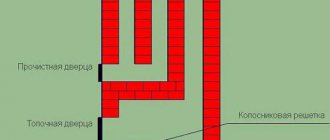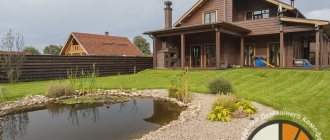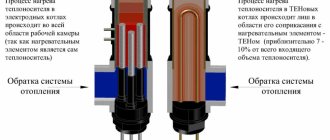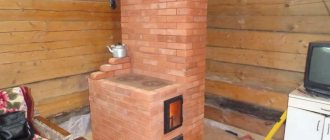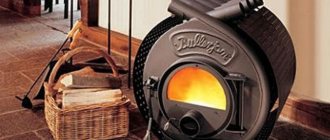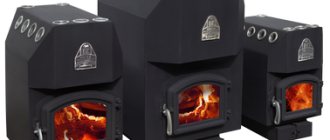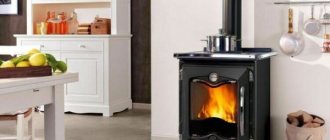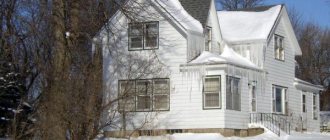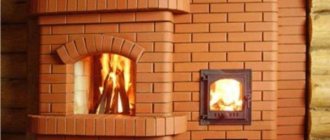You can heat your house using a water heating system. To do this, you will have to install an electric heating boiler or a boiler that runs on solid or liquid fuel.
You will also have to lay out a heating circuit and install radiators. You can take a different route and build a stove or fireplace in your house. Both options for organizing heating will provide warmth and comfort in the house. However, they suffer from two significant disadvantages: they are expensive and labor intensive.
An alternative to the two heating options listed are cast iron stoves for summer cottages, which are gaining great popularity. In this material we will try to talk about the types of cast iron stoves, their advantages and operating features.
What is a cast iron stove?
The simplest cast iron stoves are not much different in design from the notorious potbelly stove. They consist of fuel and ash chambers, which are separated by a grate. Air is supplied inside the furnace unit and the flow rate is adjusted either by the ash chamber door or using a special damper.
Smoke is removed through a pipe adjacent to the fuel chamber. Heat transfer to the environment is mainly carried out by convection. A small part of the thermal energy is transferred through infrared radiation.
Installation of a cast iron firebox
It is necessary to build a concrete foundation under a cast-iron stove.
Thermal equipment is a product ready for installation. Usually it is a prefabricated unit consisting of individual elements, and therefore requires the articulation of these spare parts. Despite the relatively light weight of the heater, it is not possible to simply install it on the floor unless it is a strong concrete base. In all other cases, preparation is necessary. The same applies to the pipe - it must protrude above the roof level, and its passage through the building structure must be fireproof.
Tool preparation
To install the heat generator in the right place, the following tools are required:
- Measuring tape. With its help, the distance of the product to nearby walls or reporting points is determined.
- Horizontal level. The product must be positioned perfectly straight.
- Jack. May be needed to level a heavy structure by lifting one of the corners and placing a support leg under it.
- Set of wrenches. They are necessary if the heater consists of different parts held together by bolts.
All these tools are not needed when a hired professional team is responsible for the installation. It is impossible to do without the help of workers if the weight of the product is not comparable to the strength of one person.
Installation location
Combustible materials near the stove must be insulated.
There are no serious restrictions for installing heating equipment in one place or another, it is important that the floor is strong and does not press through, the nearby walls are non-flammable or protected from heat, and the place is comfortable.
The operation of any solid fuel boiler or fireplace is accompanied by the accumulation of dust, so it is advisable to install the unit not too far from the entrance area, so as not to drag garbage throughout the room.
If the stove does not have any particular decorative appeal and can be connected to a diluted water heating system, it is better to install the firebox in the boiler room.
Foundation preparation
It is better to make a concrete base for the heavy weight of the heat generator. For a new building, it should be laid down immediately. To do this you need:
- Remove a layer of soil to a depth of 25 cm - dig a small pit with linear dimensions exceeding the dimensions of the convector itself by a couple of tens of centimeters in length and width.
- In each corner of the pit, go deep to 80 cm with pit dimensions of 25x25 cm.
- Insert 4 reinforcement bars into the resulting holes, driving them into the ground. In the upper part they should not extend beyond the pit.
- Fill the pits and foundation pit with concrete to half the height.
- Place a reinforcing mesh on the cement mortar and fill the foundation to the end.
If it is not possible to arrange the base in this way, but there is a fairly hard floor, it is enough to place a sheet of metal 3-4 mm thick on top of it, which must be secured with self-tapping screws. Steel will additionally strengthen the floor and will serve as protection against the loss of burning coals.
Installation procedure
Elements of a collapsible stove
To install the stove, perform the following steps:
- Take the spare parts out of the packaging and check the passport to ensure that everything you need is present.
- They study the diagram, where which part should be screwed, and find these elements.
- Twist the two side walls from the back using a bolted connection, fixing them to the lower base.
- Screw the support legs, fix the ash pan panel and the grate group.
- Place the partially assembled product in a permanent place.
- Install the front door with glass on the awnings and close everything on top with a lid with a hole to remove smoke.
- Insert the ash pan into the seat.
It is necessary to carefully tighten all the screws so that the fire-resistant gaskets fit tightly to the joint. If cracks are visible, it is advisable to seal them with fireproof sealant.
Advantages and disadvantages
The industry offers two types of metal furnace units. Country wood stoves are made of steel or cast iron. Cast iron heating devices are more expensive, but have a number of advantages that cannot be achieved when making steel products. Cast iron wood stoves for summer cottages have:
- long service life, which, with proper operation, can reach 30–40 years;
- high heat capacity and therefore retain heat longer compared to steel stoves;
- greater corrosion resistance compared to steel products; they practically do not rust with frequent “cold” fires;
- Due to the low coefficient of thermal expansion, cast iron stoves are not subject to warping and deformation.
It should be said that cast iron has an attractive appearance. Often, manufacturers' design solutions make it possible to turn an ordinary heating device into a real work of art. Many cast iron stoves become a decoration of the interior of the room in which they are installed.
Cast iron is a fairly fragile material and is susceptible to sharp impacts, which could cause it to crack. Cast iron is also “afraid” of heat shock. Cold water spilled on a hot stove can cause the metal to crack. Therefore, a cast iron stove with a hob must have a design that prevents direct contact of the flame with the stove.
When choosing a heating method for a country house, you must proceed from the fact that using a cast iron heating apparatus it is impossible to heat the air evenly in all rooms.
A cast iron stove can provide full heating in only one room. Fire safety regulations prohibit installing cast iron stove units in such a way that they heat several rooms.
Compared to brick stoves and fireplaces, cast iron heating devices have one important advantage. With comparable thermal power, cast iron units weigh an order of magnitude less. If a brick stove weighs one ton, then the weight of a cast iron stove will be about 100 kilograms.
Therefore, the installation of a cast iron heating apparatus does not require the construction of a foundation. It can be installed directly on the floor. Naturally, for fire safety purposes, it must be installed on a metal sheet or platform made of non-combustible material.
Pros and cons of cast iron stoves
Cast iron is a durable and heat-intensive material; a wood-burning stove for a summer cottage made from it retains heat for some time after the wood burns out in the firebox. In addition, cast iron heaters have other advantages:
- Durability (25-30 years). The property of the material to resist corrosion for a long time gives cast iron stoves a great advantage over metal ones. They do not rust from the effects of condensation that occurs during cold kindling, and therefore can easily withstand periodic use during the cold season.
- The walls of the cast iron firebox do not corrode or collapse under the influence of condensation mixed with soot and ash. This mixture contains acids that corrode products made from ordinary metal.
- Wood stoves designed for heating country houses and cottages are distinguished by their aesthetic appearance and original design.
- Thick cast-iron walls of heating and heating-cooking units contribute to long-term heat retention.
Branded potbelly stove from the Norwegian brand Jotul for 290 euros
The thick walls of the cast iron firebox are a double-edged sword. They take a long time to cool down, that's true. But they also require more time to warm up, which means that a cold stove at the dacha takes longer to heat up.
A significant drawback of heaters that scares away many users is their price. To buy a cast iron stove to heat your home, you will have to pay 50-100% more than a wood-burning steel heater costs. The remaining disadvantages are not so significant:
- the heat source has a decent weight, which should be taken into account when placing and installing it;
- when using a cast iron cooking stove, do not spill water on the hot surface, otherwise it may crack due to temperature shock;
- The material is fragile and can crack under a strong impact.
Stove-fireplace with an original design from the INVICTA brand (France) for 2800 USD. e.
For reference. Cast iron will not crack if the unit accidentally falls during transportation. This means a strong blow with a hard object or tool, such as a hammer.
What is the efficiency?
It must be said that the simplest cast iron stoves for the home have a relatively low efficiency factor (efficiency factor). Usually it does not exceed 40%.
Long-burning furnace units have higher efficiency. To increase heat transfer, they are equipped with a chamber in which pyrolysis gases (flammable gases formed during smoldering wood) are burned. The air supply to this chamber is adjusted separately.
Experts are constantly working on the problem of how to improve the heat transfer of a cast iron stove. One way to increase heat transfer is to add so-called “smoke circulation” to the stove. Passing through the smoke circulation, hot smoke travels a longer distance and gives off an additional portion of thermal energy.
Sometimes, in order to increase the heat transfer time of a cast iron stove and increase the efficiency, ceramic heat accumulators are installed on chimneys.
Which design to choose for a country house
What cast iron heating stoves exist for a country house and how do they differ? By function, all structures can be combined into three large groups - heating, heating and cooking, fireplaces. Heating units are intended exclusively for heating rooms. They are designed to maintain temperature for as long as possible. There are models with advanced functions.
Diagram: operating principle of a gas generator stove
Long-burning heating stoves
Among heating stoves, convection and gas generator stoves are of particular interest. The former ensure the circulation of warm air between the walls of the firebox and the body, due to which they warm up the room faster, and gas-generating furnaces operate on the principle of double combustion of fuel. The design of gas generator furnaces differs from traditional models. In the first chamber of this design, the fuel burns slowly. The pyrolysis gas released during the combustion process enters the second chamber, where it is burned, and the heat is used to heat the room.
In temperature maintenance mode, gas generator models can operate for several hours. They use fuel economically and rationally, and their efficiency reaches 80-85%. There are models with automatic fuel supply. This is an expensive pleasure, but the home owner does not have to constantly monitor the consumption of firewood.
Drawing of the Buleryan stove for making it yourself
What types of cooking and heating models are there?
The upper part of such structures is a cooking surface - solid, with one or more burners. They are designed for cooking, heating food, and drying fruit. If desired, you can find designs complemented by a barbecue and/or oven.
Models of this type successfully combine two functions, but they cope with heating worse than “highly specialized” designs. They are best installed in small houses. For spacious rooms, it is worth choosing powerful long-burning heating stoves.
Models stylized as hearths, fireplaces, and tiled stoves look very beautiful. They often become the main detail of the interior. Stoves with glass doors and decorative elements look especially romantic. They are multifunctional - this is a plus, but the disadvantages include lower productivity, because... models hold heat worse.
Cooking and heating model with oven
Fireplace stoves - heating and romance in one bottle
Wood stoves with glass doors have remained popular over the years. On the contrary, they are increasingly in demand among buyers who pay special attention to the aesthetic aspect in home design. The sight of flames creates an atmosphere of romance, warmth, and intimacy. The doors are made of high-quality heat-resistant glass. The material is reliable, safe, and does not emit harmful substances. Designs of this type are more practical and fireproof than open fireplaces. In addition, they do not require major modifications to install a chimney, which will inevitably have to be done if you build a traditional fireplace.
The main function of such models remains heating the room, but aesthetics also play an important role. The reflections of fire on glass and pieces of furniture are unique light-color effects, the beauty of which lies in their unpredictability. There are corner structures, and there are also those that can be placed in the middle of the room. It all depends on the needs and wishes of the buyer.
Decoration of the stove-fireplace
Types of models
Manufacturers offer several types of heating units made of cast iron. Conventionally, they can be divided into:
- conventional cast iron stoves;
- fireplace type stove units;
- heating and cooking stoves made of cast iron;
Fireplace-type stove units are equipped with transparent combustion doors and side heat shields made of heat-resistant glass. When such “fireplaces” are heated, a unique cozy atmosphere is created due to the warmth and sight of burning logs.
A cast iron stove with a cooking burner will not only provide the room with heat, but will also allow you to boil water for tea and make coffee. Not every housewife will regularly cook food on it. For this, it is more convenient to use a compact gas stove. However, this option may also not be superfluous.
Requirements
- Heating a country house is fundamentally different from heating a permanent residence for several reasons.
- Most gardeners do not come to their dacha every day, but only on weekends. Within a week, the house and the stove itself have time to cool down. Therefore, a stove for a summer cottage should quickly heat up itself and heat the room, while firing a cold stove should not cause difficulties.
- Many people arrive at the site in the evening, and there is no time to light the stove for a long time. An ideal country stove should retain heat for a long time or have a safe, long-burning mode.
- Lighting up a cold stove often leads to the formation of condensation on its walls. Soot and soot combined with moisture form carbonic acid. Elements of the stove and chimney must be resistant to weak acids.
- The size of a country house is usually small, so the stove must be compact, while efficiently heating its internal volume.
- The presence of a hob will eliminate the need to install a stove.
- The appearance of the heating device also matters - a beautiful stove model decorates the house.
Thus, an ideal stove for a summer residence should have the following characteristics:
- fast heating and slow cooling;
- the presence of a long burning mode;
- high efficiency and efficiency;
- corrosion resistance of firebox and chimney elements;
- presence of a hob;
- compact dimensions;
- decent appearance
- wide price range.
Modern cast iron stoves meet all these requirements. They have different thermal power, design and additional functions that decorate the life of a summer resident. Choosing a stove is a crucial step, so you need to understand the intricacies of their design and operating principle before giving preference to any model.
Types of fuel used
The long service life of a cast iron stove is ensured by using the “correct” fuel. It is best to fire with dry hardwood firewood (oak, hornbeam, birch, etc.).
They have high heat transfer with relatively low fuel consumption. Coniferous species are less suitable. Damp wood is difficult to light, it burns “reluctantly” and does not emit enough heat.
You should not use coal as fuel. Coal has a higher combustion temperature compared to wood. Therefore, there is a high probability of overheating the stove. When cast iron is heated above 450°C, the structure of the metal irreversibly changes, causing its heat capacity to decrease. After the stove overheats, the unit will work noticeably worse.
Disadvantages of steel furnaces
- Average efficiency indicators. Comparing different models, you can find frankly cheap potbelly stoves on the market, the efficiency of which is about 40%. That is, more than half of the thermal energy goes into the chimney, which makes heating with such a stove quite expensive. Middle-class steel furnaces have an efficiency of 60%, the approximate standard is up to 80% (if this condition is met, this parameter can be considered an advantage);
- Low heat capacity. After the fuel stops burning, the stove cools quickly; lining may be required;
- Lots of problems with the basic structure and cladding. If the steel is thin, the stove may rust, burn out, or wear out at the seams;
- Mandatory conditions for ensuring fire safety associated with serious heating of the furnace walls. The same applies to standard operating rules, which must be strictly observed to avoid burns;
- There is a possibility of significant deformation of the walls and frame of the furnace due to constant sudden temperature changes. Not only the internal structure is violated, but also external data;
- Short service life, at best limited to a period of 15 years!
Many manufacturers are accustomed to praising their own products. And this is not surprising, because these are the rules of modern marketing. The only shame is that most brands and dealers significantly inflate the quality of their products. And this applies not only to the composition of the steel, its purpose and, strictly speaking, compliance in general. But also the thickness of the material, the power of the furnace, the possibilities of heating rooms of different sizes. The product description often specifies an increased service life. In specialized advertising articles, for example, it is indicated that the average service life of a steel furnace with a wall of 4-5 mm is about 30 years. Unfortunately, we do not know of a single living confirmation of this!
But, despite all the shortcomings and flaws of advertising campaigns, there are good steel stoves on the market. Their service life without repair is consistently up to 5 years, with minor adjustments and restoration – about 15 years. A heating device for 10-15 thousand rubles, which lasts for such a significant period, is a good choice!
How to choose?
The main criterion for choosing a heating device is its thermal power. Thermal power is selected based on the area of the room or its volume. Typically, manufacturers in the technical documentation indicate the volume of the room that can be heated using a particular model.
Having decided on the power of the stove unit, you need to decide on its type: a simple stove, a “fireplace” or with hobs. When choosing a stove for heating your home, you need to focus on reputable, reputable manufacturers.
Among the well-known brands we can recommend:
- Belgian heating units EFEL,
- products from the Polish manufacturer EUROKOM,
- Russian-made products from ARDENFIRE META,
- Italian EdilKamin.
Range of offers on the market
- Cast iron and steel stoves, combined heating devices;
- Household stoves, fireplaces, heating and cooking stoves;
- Chamber, bell-type and channel furnaces;
- Shape: round, barrel-shaped and rectangular;
- By color: black, steel, patina, bronze, anthracite and others - more than 50 colors and shades;
- Standard stoves with a door without glass, as well as fireplace stoves with glass, double glass, prismatic or panoramic glass;
- By fuel type: firewood, briquettes, pellets, coal, combined options;
- By type of heating: radiant heating, convection, with warm air distribution, with the ability to connect heating radiators;
- In terms of power, on average, from 1-3 kW and up to maximum values, depending on needs;
- To meet the requirements of smoke removal systems with chimneys of various diameters;
- Furnaces with or without an ash pan, with or without grates, with different connections for chimney ducts, standard and with fireclay inside, equipped with a clean glass system or an air supply, equipped with a double afterburning system, with temperature and power control, equipped with automatic equipment.
How to install a cast iron stove in a wooden house with your own hands?
Wooden buildings are the most fire hazardous. Installing a cast iron stove in a wooden house with your own hands requires strict adherence to fire safety rules:
- As already mentioned, heating appliances made of cast iron are relatively light in weight. Therefore, they can be installed directly on the floor. To prevent fire, place a thick steel sheet on the floor or lay out a podium made of heat-resistant ceramic tiles. If the weight of the stove unit exceeds 100 kg, then the floor is reinforced from below with additional supports. You can also build a concrete or brick foundation.
- Heat screens are installed on walls located close to the heating unit to prevent heating of wooden structures. Some furnace manufacturers include such screens in the delivery of their products.
- When installing chimneys, where they pass through wooden (combustible) walls and ceilings, thermal insulation of heating parts is performed.
Reputable manufacturers provide detailed instructions for installing stoves and fire safety measures. If all recommendations are followed exactly, the operation of stove heating will be safe.
Basic criteria for choosing a metal stove for the home
- First of all, decide what exactly you need and set a budget for purchasing a new stove. Deal with the topic yourself, consult with your family, consider possible options initially for their intended purpose. Why do you need a stove: to cook food, heat the room and cook at the same time, or more to improve the interior? It depends on what kind of stoves and their characteristics to study, standard heating, heating and cooking stoves or fireplace stoves;
- Next, decide on the material of manufacture, also based on the budget and the given characteristics. Try to consider products made from high-quality heat-resistant steel or cast iron;
- Find offers from manufacturing companies in official retail outlets, in online stores, study the features, select several of the best and most appropriate models;
- Make sure that they can be installed in the selected room, check the dimensions, weight, and fire requirements. Think about the installation of the chimney in advance, check its diameter;
- Pay close attention to the visual assessment. You shouldn't buy a steel or cast iron stove if you've only seen it in a few photos;
- Take time to inspect the structure and seams, read the description in the passport, talk to consultants and ask for product certificates. If you are an experienced buyer, during a consultation with the seller you will immediately determine at what points he is fussing and simply forcing the product on you;
- Efficiency, power, and preliminary calculation of the stove’s capabilities for heating the room are important. As a standard, the calculation is made based on 1 kW of power per 10 square meters of room, provided its height is within 3.00 meters;
- Specify the type of fuel, its burning period, request the operating instructions and maintenance rules;
- Move on to external features and design additions that improve usability or design. Try to choose from stoves that have the classic configuration of an ash pan, grate, sealed doors, and a hob;
Be sure to check the terms and conditions of the warranty, request a sales receipt and product passport, and make sure that all documents are completed correctly!
